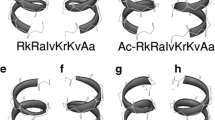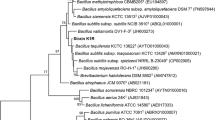Abstract
Antimicrobial peptides (AMPs) are novel agents for therapeutic application for their inherent broad spectrum of activities against bacteria, fungi, and viruses, as well as anti-inflammatory, anticancerous, and immunomodulatory activities. This chapter presents an enzymatic method to generate glycovariants of one such antimicrobial peptide, namely enterocin 96, using a bacterial protein O- and S-glycosyltransferase, in vitro.
Access this chapter
Tax calculation will be finalised at checkout
Purchases are for personal use only
Similar content being viewed by others
References
Schäffer C, Messner P (2017) Emerging facets of prokaryotic glycosylation. FEMS Microbiol Rev 41:49–91
Maky MA, Ishibashi N, Zendo T et al (2015) Enterocin F4-9, a novel O-linked glycosylated bacteriocin. Appl Environ Microbiol 81:4819–4826
Nagar R, Rao A (2017) An iterative glycosyltransferase EntS catalyzes transfer and extension of O- and S-linked monosaccharide in enterocin 96. Glycobiology 27:766–776
Wang H, Oman TJ, Zhang R et al (2014) The glycosyltransferase involved in thurandacin biosynthesis catalyzes both O- and S-glycosylation. J Am Chem Soc 136:84–87
Stepper J, Shastri S, Loo TS et al (2011) Cysteine S-glycosylation, a new post-translational modification found in glycopeptide bacteriocins. FEBS Lett 585:645–650
Oman TJ, Boettcher JM, Wang H et al (2011) Sublancin is not a lantibiotic but an S-linked glycopeptide. Nat Chem Biol 7:78–80
Izquierdo EC, Wagner C et al (2009) Enterocin 96, a novel class II bacteriocin produced by enterococcus faecalis WHE 96, isolated from Munster cheese. Appl Environ Microbiol 75:4273–4276
Author information
Authors and Affiliations
Corresponding author
Editor information
Editors and Affiliations
Rights and permissions
Copyright information
© 2019 Springer Science+Business Media, LLC, part of Springer Nature
About this protocol
Cite this protocol
Nagar, R., Rao, A. (2019). In Vitro Synthesis of Bioactive Glycovariants of Enterocin 96, an Antimicrobial Peptide from Enterococcus faecalis. In: Brockhausen, I. (eds) Bacterial Polysaccharides. Methods in Molecular Biology, vol 1954. Humana Press, New York, NY. https://doi.org/10.1007/978-1-4939-9154-9_22
Download citation
DOI: https://doi.org/10.1007/978-1-4939-9154-9_22
Published:
Publisher Name: Humana Press, New York, NY
Print ISBN: 978-1-4939-9153-2
Online ISBN: 978-1-4939-9154-9
eBook Packages: Springer Protocols




